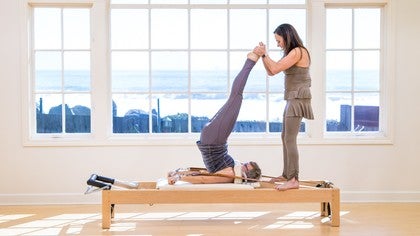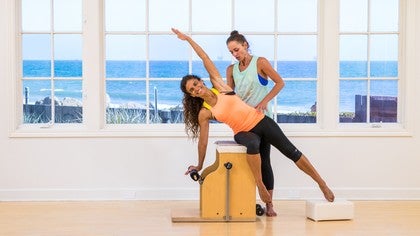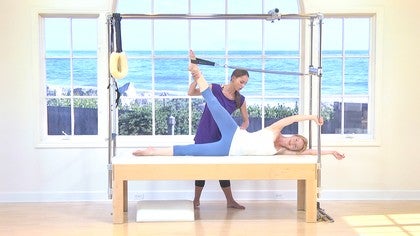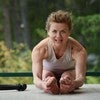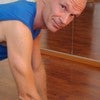Description
About This Video
Transcript
Read Full Transcript
Hi, I'm Claire Dunphy Hemani and today's tutorial is to hopefully help you and help Karen here meet Karen, lift the hips correctly, so as to not hurt the back. And Karen shared with me a few minutes ago that the exercise she's having difficulty with is the overhead. So we're going to take a look at the overhead, take a look at how she's trying to get at it, and then I'm going to get to work and try to help her figure out what she needs to do in her body in order to properly execute safely and successfully the overhead. So that's what we're up to today in this tutorial. So the first thing I want to do is look at you doing the overhead. Okay. So we'll have the foot bar down, we'll be on two springs. Head rest is down.
And I know Karen's already warmed up a little bit right from before, from, from the before. So we're just going to start with the overhead. So okay, come onto your back. Just come on, come on down. And we're going to try to look and see what's giving, giving difficulty. So take the handles in your hands. And you've tried this before, right? I have not on this equipment. Okay? So just hold the handles just like that. And we'll start with your legs at the ceiling. Okay.
Now one thing we do know is that if she's doing the overhead, she's already done footwork and the hundred and then this would be the overhead. So already I'd be able to see how she's working in her powerhouse. Cause what I immediately think of when somebody is having an issue lifting their hips is I'm gonna make sure that the hip extensors are working correctly and I'm going to make sure that the reach of her arms is actually supporting the movement as well. So we're going to start right here in here, okay. And you're just going to do it without my cues. Okay, go ahead. Okay. And can't get up. All right. So now I'm going to give her a little assistance and I can see she's got some tension in the toes and I can see that she's wanting to have her legs go without lifting from the hips. So we'll do it together.
And I'm going to heavily spot you so that you can feel it. So hold the legs there. So go ahead and press in to the straps and push up to the ceiling. Push up, push your legs up, up, up, up, up. You okay there.
Now reach into your straps and start to roll down and I'm just going to support you as you push into your straps and reach and reach and reach and reach and then take your arms up to the ceiling. Okay, rest a second. Okay. Before I would even bring Karen to the overhead, if I was working with her and I am, um, I would want to make sure she's lifting her hips correctly in the short spine massage, which would have been introduced before that. So let's go ahead and look at the short spying massage
I am intentionally doing that to make sure she's lifting her hips up and she's okay. Lifting your hips up. Okay. Bend your knees and bring your heels down.
It's not a hamstring stretch. Let these bend the, yeah, now pull. Okay. Let's see if we can break it down. I can break it down for you. When the legs go out in space, I want her bottom to be what initiates the movement of the legs over instead of having the legs move and then the bottom, because that's her issue with her overhead. So she's going to learn, figure it out in her body using the short spine first. Now go out and I'm going to hold. I'm going to hold here, not pinch your bottom. That's what starts the movement. Keep with it, keep with it, keep with it, keep with it, keep with it. Now the knees bend to the shoulder blocks right to here and now roll your back out. It's about your spine. And then when you can't go anymore, you bring your heels in. So you're working into your back.
And the other thing I noticed with Karen is she's got a stiff part in her back. So I'm, I'm curious now if her hip flexors aren't dominating her body and pulling the lumbar spine anteriorly a little bit. You know, so this and this together is what's gonna bring strength into all of her movements. So we'll do this one one more time. Push away, pinch your bottom, curl up over, work in here. That's it. Now Bend your knees down, leave your feet. And now we start to make our role and I want to feel you've got all these bones but want to make sure these bones are starting to come down, right? And then bring your heels in and continue that role. Okay, so that's enough of those. So I would make sure that was happening.
And you know what's interesting is this issue is going to show up in every single exercise throughout her whole reformer part of her session. Let's take these off your feet all the way through to you know everything it's going to show up cause it's a weak point. So that will then give me a clue as to the exercises I can give on other apparatus that can help improve this, you know, p motor pattern and the strength in that motor pattern. And specifically it's going to be about initiating the hip lift from the correct spot. So let's think about the exercises. The other exercises where this is going to show up.
It's going to show up in short spine. It's going to show up in the corkscrew when we have to lift the hips, the long spine massage when we have to lift the hips. And of course the overhead where you have no help at all from the straps on your feet. Okay, so with the straps are on your feet, like in short spine, you can see how it gives you the feeling. So what we're gonna do now is we're going to head over to the Cadillac, keep straps on her feet, work through a few movements there, and then come back to the reformer and see if we've made any headway in progress. Okay. So here we are, I'm over at the Cadillac and with Karen, I just want you to face the face to mirrors, you know, just face the camera for a minute. And one of the things I'm noticing with Karen is, um, she tends to have her weighed on her heels and her knees, a little hyperextended in the back.
So this is gonna be really kind of important to get and translate everything back up to a standing position. So, um, how are your knees? Do you have any pain in the backs of your knees ever? No, you're good. Okay. Alright, well we're gonna get started and we're going to go over to legs springs. And I asked that because if somebody has pain in the back of their knees, then we wouldn't really do leg springs. We would go somewhere else, like the spine corrector. So come on to your back. I'm going to put the straps on the feet. There's one, there's two, okay. And your knees will start bent and your hands reach back to the vertical bars and you have your thumbs with your fingers so that your hands are actually pushing. Okay.
Now one of the things that I want to address is that we're looking at the whole body. So how she and anchors the back of her rid the bottom of her ribcage in the mat really is going to matter. And why it matters is that that ribcage lifted is a telltale sign that the soul has is very tight and that's a topic for a whole nother day. But just keep that, keep that in your mind that when the rib cage is flaring there could be an issue and we really want to make sure that there's a good connection there in the upper body, even though we're working down in the lower body because the lower body is also closely connected into the lower back. So the hips working well has a big impact on whatever's above it and below it nice and back. Okay.
And because the back is so close to where the back ribs are now, you can kind of get how it's about that whole length of the body. And I'm going to, uh, actually hop up here with you. Okay. So you've got your back rooms anchor down and I want your knees bed. Yeah. And just enough pressure into the spring that the springs are open. But you're anchored from here. Okay. Cause this is where I want you to concentrate. Okay. Alright.
So reach the legs out like frog. Reach out to here, hold it and come in and just do a few like that. Can you look towards me with your eyes so that your legs are on an angle and you see how our hips want to lift? Big Clue. We just got ourselves another clue. Reach in, reach in. Resist the way in so that you're not pushing from the tops of your legs. So your reach come in and reach. Come in, see how the ribs are starting to lift so that you got to concentrate on that too. It's a simple frog movement. You're working too low, you gotta be able to, yes, there you go.
Now stay thought. I'm going to see if she's stable. I want to try to push her a little. Don't let me move you. It's a little trick, mom. Don't let me move you. Don't let me move you dig in. What do you have to do to not let me move you? It's not about your legs, right?
It's about finding how to be still right in there. Okay? Bend your knees in and take a little rest. Rest your arms for a second. Okay, so you're really, when you're in that position, it's full on. You're reaching, you're reaching and you're pulling us all together. Okay, let's go ahead again. Reach out. Anchor this down. Good. Break in the hip. Break in the hip. Get this down. Yeah.
Good. That's a lot of work for you. Isn't it? Good. Keep it up. Now we're going to go into circles. I'm going to stand here so I can guide your legs to start with. Okay? Come up. Circle. Pull them together. Up Circle.
Pull them together and around together. See she doesn't want to press them down. Push from the Tush and our round together. You see where my accent is and around again, I want you to hold there. Hold it, hold it there and around together. Now reverse it around and reach and around and reach and around.
I'm getting out of the way. Reach and squish my hand right here and reach one more time and around and reach and bend your knees in. Whoo. It's a lot, huh? Okay. Now we're going to do something with the airplane board. Okay. So let's take these straps off and then we just take the loop off. And if he's not worked with an airplane board before, it's wonderful cause it's great to align the feet and the knees and the hips and it acts like Kinda like the roll back bar.
It's a little bit more stable than working independently. So this is going to give it, give her a chance to really, um, get to the next step of lifting her hit. So we're going to be doing the airplane using the airplane board and the feet go in. And how this works, Karen, is that you put your feet all the way into the, so the ball, your foot, the metatarsal shows up through the top. Okay. And your hands go back again. Have you done the airplane before? I've done the airplane. Okay, so we're going to start right here and look towards me and let's align your knees in a little closer to your working parallel. And look at this foot.
Let me see. Keep this foot nice and straight and you're really standing as equally as you can and anchor through your hips. So anchor back down into the mat. Okay, we're going to gradually build her into this. So just curl your hips up and curl them down and again, curl in and rolled down. Does that feel good? Curlin now push the board up to the ceiling and stand on it. Lift your back, lift your back, lift your back. Now push out.
Good. Push out and push out and push out and roll and push out. Push out, push out. And I'll bring your heels in. [inaudible] keep the alignment of your legs curl in. Now push up, push up to the ceiling, and then out. Out. Go ahead out. Nope, straight, straight. Let's go ahead. Push up, go reach, push out, push out the legs. Push out this. Open the spring. Open the spring, roll it out a little bit. Roll. Let's get you down and let's get you down.
Get you down. That's okay. See, this part's important. Now push up and out. So it's not a huge role, but you are touching down. Reach, reach, reach, reach, and reach. Now lift your hips in the air and go up, up, up. There you go. Bend your knees straight down and then roll. Don't get your knees in. Yeah. Okay.
Push out again from the toes. I'll use your bottom and lift up in the air. Fly in the air and bend your knees down. That's it. And then rural one more like this. Out Low. Lift your hips up. Try to stay right in the center of these rails. Good job, Ben. And push into the arms and roll right where my foot is touching your back.
Okay. Now take your feet out from the airplane board and we're gonna put the straps back on and work on the articulation in one more way. How'd that feel? That was awesome. Does it feel good on your back? Okay, really good. It took a couple of times to get the feeling of pushing up into the position enough. So pushing up into the position with springs is going to teach her how to push up without springs, which is why we use the springs is to get the feeling in the body.
Okay, so now this, um, this is just going to be a little variation, um, for her. Open your knees apart. Good. Anchor your hips. Anchor your rib cage. So reach out to me like shorts by. So pushups now leave your legs there and curl your hips up, up, up, up. There you go. And roll down, roll down, keep reaching out and bend your knees in. Good. And again, press away. Keep your legs still and lift up.
There you go. Now hold your legs still and roll down. Keep them still. Roll through your back and bend your knees in. One more time. Stretch and hold. Steer yourself in the middle of these rails. That's it. Keep them still roll yourself down. There you go.
And that's a simple thing that you can practice on your own and bend your knees in. Okay, good. Let's take these off and stand up. Now we could basically do similar movements using the tower. We can also do the shoulder roll down where we're accenting how to work from the back of the body and, and articulate. Um, so what, at this point, I don't want to tire her out too much. I want to head back to the reformer and now see if we can apply some of what she's learning and have a success at the overhead. So we'll go back to the reformer now. So here we are, we're back at the reformer. And to start with, I want to set Karen up for success.
And after just knowing what we just did on the Cadillac, I'm going to bring into play what I noticed about the ribcage. So I want the, the reach up in the anchoring down because that's gonna make her stronger to get this action through her hips. The second thing is she's wrapped up, she's all, all these muscles are already like awake and fired. Okay. And so now raise your legs, pull on the straps and lift your hips over. Now up, squeeze your bottom up to the ceiling. Push up, push up from here, push up from your bottom and then start to roll back. Reach into your straps, reach more, reach more, reach more, reach more, reach more on the mat, and then stretch the arms up to the ceiling. So bend your knees in. So what I'm missing so I can feel it, what I'm missing is that she's, she's not quite pressing up as she goes down. So that's what we're going to work on, on this repetition. So stretch your legs, stretch your legs out, let the ribs come down.
And I could have her start with her legs up, but I want her to get, I want you to pull your arms from here. So go ahead, pull the arms and your bottom up. Caught Ya. Ha Ha. So you see what she tried here? She tried to throw her legs. So we're going to do it from here. Now get your ribs already down.
So the trick is lifting. Nope, not from the tops of your legs. Pinch your bottom. Pinch your bottom. Pinch your bottom. Pinch your bottom. Lift up to the ceiling. Don't go back too far. You won't be able to hold it. Now roll down, roll, push into me, push into me and then raise your arms to the ceiling. So we would have to work like that. However, in the mat work, let's hang that up. In the mat work. When we're practicing like the Jackknife, there's a few things that she can do that will really improve that.
So without the straps, just take your legs up to the ceiling, wrap around in your seat, tighten around in your seat. That's it. And I'll push up into my hands and curl and lift. There you go. Now. So feel me. Now start to roll and keep pushing. Yup. Yup, Yup. Hips to the right a little bit. That's it. And then the arms come up. Now take the straps, get your up. There you go.
Pull on the straps. Come over. Yes. Then up. Beautiful Karen. And then take your time. Stand on me. And I'm just giving her a little pressure to iron out or back. He pushing up right now. Right now, right now. And then the arms return. So you really need to hold on at the very bottom. One more. Here we go.
Hips. Yup, we're getting there. And then roll, take your time. When you get to your lower back, reach into your strats, reach into your straps, reach into your straps, and then the arms come up. Okay. Bend your knees and rest. And I, that's how I would work with Karen. And in a month she's gonna have her overhead because she's putting together all the pieces of the puzzle and our bodies have a puzzle to figure out. So why don't you swing your legs around to the side. And one of the puzzle pieces is not throwing legs, how the rib cage kind of plays into it, how the straps reach and how the legs reach.
So we're going to take a second and listen to how Karen experiences in her body to see what she was able to glean from the experience. So Karen is going to share with us what she learned in her body as we went through that. So how'd it go for you? What did
And even the reach into the straps, um, as I was reaching and moving my ribs back into the carriage, I had always been busy, ready to pull into shoulder extension. And so that sort of gave this extension moment to my spine. So I was much better able to stay flexed in my spine. So that was just more accessible to me as I came up. So that was fabulous. Yeah. Two really wonderful. Yeah.
He learned out of that and, um, and I want to thank you. Thank you. It was great. Thank you so much.
The Teacher's Corner: Speaking with your Hands
Comments
Good Luck! Clare
You need to be a subscriber to post a comment.
Please Log In or Create an Account to start your free trial.
